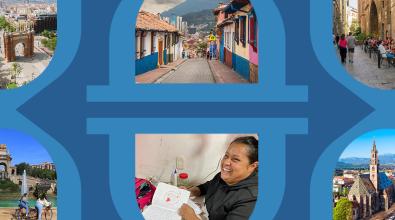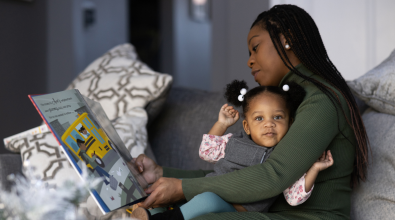Mayors Challenge coaches and the advice they shared with global cities

From left to right: Jaeyon Yu, Njeri Ndonga, and Sarah Gallimore.
The first phase of the Bloomberg Philanthropies Global Mayors Challenge wrapped up last week with more cities from more countries submitting more Mayors Challenge applications than ever before. These cities are now competing to be one of 15 that will win $1 million each to implement a breakthrough idea that represents the world’s leading urban innovations to emerge from the COVID-19 pandemic. The 50 finalist cities that will advance to the second stage of the Mayors Challenge will be announced in June.
Before submitting their applications, more than 1,900 city leaders attended one of the nearly 500 virtual workshops Bloomberg Philanthropies held over six weeks in February and March to help cities better define the problems they’re hoping to solve, better engage partners in and out of government, and better understand what quantitative and qualitative data they need to bring to bear.
To find out more about the learnings coming out of these workshops—and insights that cities everywhere can put to work—Bloomberg Cities caught up with three coaches who each ran a dozen or more of the sessions:
- Njeri Ndonga, a storytelling consultant based in Nairobi, Kenya, led workshops with cities across Africa.
- Jaeyon Yu, a lecturer in design thinking based in Berlin, Germany, led sessions with cities in South Korea, where she is from.
- Sarah Gallimore, an experience designer, strategist, and futurist who has served on innovation teams in Durham, N.C., and Detroit, led workshops with cities across the United States and Canada.
What was it like for you to facilitate these workshops?
Njeri Ndonga (Africa): It was intense, both physically and emotionally, because you realize that you're talking to people who are very invested in the work they do. A lot of them have served in government for 10, 20, or even 30 years. And the problems they’re facing are very complex. It’s very hard to be serving a city that has 4 million people and look at an issue like health and then narrow it down to one thing. For solutions to work, you have to solve so many moving parts.
Sarah Gallimore (U.S./Canada): It was an honor, honestly, to be a touch point for 14 different cities in the middle of a pandemic, as they’re thinking about critical systemic problems and helping to move them toward a more actionable place. These public servants oftentimes are residents of the city, too. And they deeply and truly want to create positive change.
Jaeyon Yu (South Korea): This was the first time I’ve worked with city officials, and I was really surprised by their passion. I had a stereotype in my head of public officials, you know, just doing the same work every day. It was amazing to see how much they’re taking care of citizens’ lives. It gave me goosebumps!
Were there any themes you saw in the problems cities are seeking to address at this stage of the pandemic?
Njeri Ndonga (Africa): An overarching theme I saw was economic support for citizens—finding solutions that create jobs for the people. And solutions that, by creating jobs for the people, create revenue to address other problems facing the city. When we look at statistics for the African youth population, compared to the older generation, there's a constant question of what opportunities exist for them. The cities identified that as a problem and saw the need to involve youth in creating opportunities for them. That was a connection I felt all the cities I spoke to understood and respected.
Jaeyon Yu (South Korea): The topics were very different and fascinating for me to see: public safety, environment, public health, hygiene, mental health, housing issues, tourism—everything. I led workshops for 13 cities and none of them had the same topic. The one commonality was that COVID made a lot of existing problems even worse. That was a shock to all the government officials.
Sarah Gallimore (U.S./Canada): I saw a lot of cities looking at the food system in different ways. With the pandemic affecting food delivery, there are a lot of cities taking a fresh look at what their food systems look like at a hyper-local level. Then, with the difficulty of being inside during this pandemic, many cities were focused on how to better utilize their outdoor spaces. Not just parks, but also streetscapes and vacant lots, and other underutilized land, and figuring out how to make it an asset for citizens.
In terms of addressing those problems, what sort of things did you see cities struggle with?
Jaeyon Yu (South Korea): Many cities were thinking about their solutions before they’d really defined the problem. They were making assumptions, because they’d think everyone knows that something is a problem. In the workshops, I would ask them to bring data that shows what the problem is. And I would say they need to actually talk with the people who are facing the problem. Not many officials were comfortable with doing both of those things.
Sarah Gallimore (U.S./Canada): They often struggled with connecting the dots between the way they're framing their problem and the metrics for impact or outcomes they were hoping to see. And then, beyond the problem frame, drilling down into it to ask: Who specifically is this a problem for, and why is it a problem for them in particular? And figuring out how to maintain resident engagement after something has been implemented—I think that was something a lot of them were trying to wrap their heads around.
Njeri Ndonga (Africa): The internet connection—that was the main challenge on every call! But in terms of the work, one of the challenges is where cities’ problems, like garbage collection, have persisted for a very long time. Another challenge is where you realize that the cities are now having to solve the problem of rapid growth, but also think about planning for the future. There was a challenge in trying to balance their ideas so that we are first addressing what we are faced with, but we are also trying to create a holistic solution that can change as times and circumstances change.
What were some strengths you saw from the cities you worked with?
Sarah Gallimore (U.S./Canada): Collaboration. Many of the cities came to these workshops with their partners already on board. They were involving key stakeholders, whether it was internal city departments that typically wouldn't work together or community partners. That was really amazing to see. There also was a deep interest in engaging residents in an in-depth way. I heard from more cities than I expected that they had already started to put together a plan around how to do that, or were already drawing on things they had heard at meetings with residents.
Njeri Ndonga (Africa): One thing I noticed was that the solutions were very simple. By simple, I mean that when you think about innovation, there's often a lot of talk about technology and it gets complex—you digitize everything, and then cloud, and then Blockchain. The thing I noticed with the cities is that they did not have the urge to be pompous or to overcomplicate their solutions. They were very simple and also very directed on the problem they want to solve and how they want the community to benefit. There was a lot of focus on the community, which I thought was very, very positive. And there was also a lot of focus on not leaving out low-income and underserved communities.
Jaeyon Yu (South Korea): One of the cities I worked with was dealing with a public safety issue affecting women. And they’d interviewed at least four or five of the women who are actually having this problem. All the things that I would tell them to do, they were already doing it!
What’s one lesson you shared with participants that would be helpful to anyone trying to bring a more innovative approach in local government?
Njeri Ndonga (Africa): One lesson across the board was around understanding the problem they’re working on. I spent way more time on defining the problem than any other thing. Just doing that made everything after very simple to do because it meant that whatever else we discussed after had a really strong foundation.
Jaeyon Yu (South Korea): What I told them was that it would help their budget if they first focused on defining the problem. In the private sector, 80 percent of startups fail because they don’t really get what the market needs—they produce something they assume others will like but they don’t really know. By saying this, I think officials found it easier to understand.
Sarah Gallimore (U.S./Canada): The importance of using plain language and being concise storytellers. It’s a good exercise for government teams to practice speaking more directly to residents. I kept saying: How would you explain this to a resident? Would you walk up and tell them that they're facing “food insecurity” or that they are a victim of “blight?” No. And they wouldn't describe the problem that way either.





